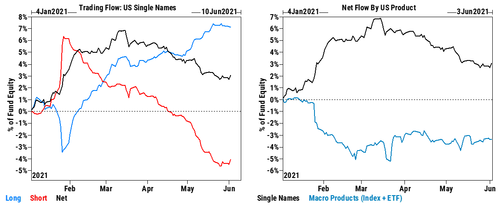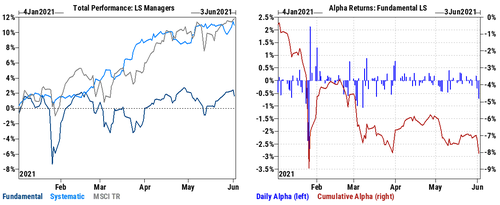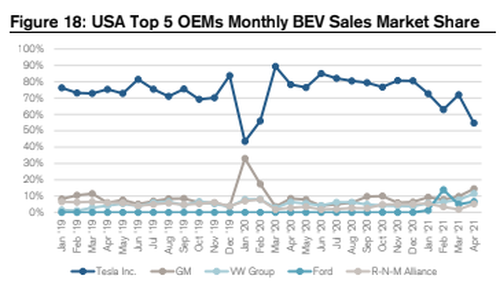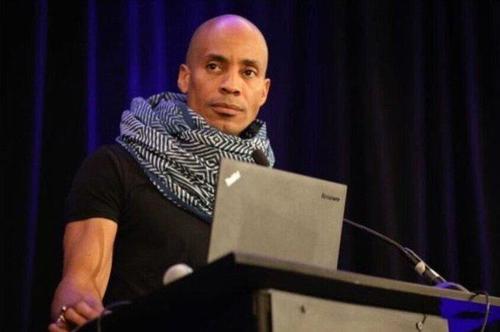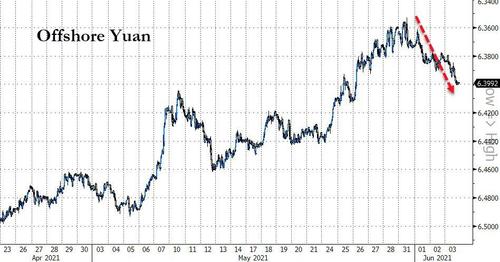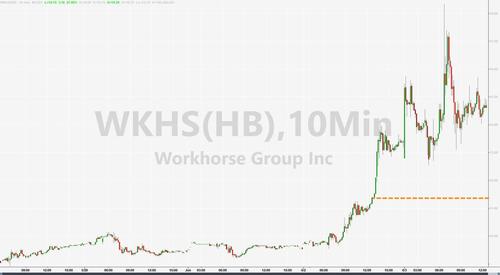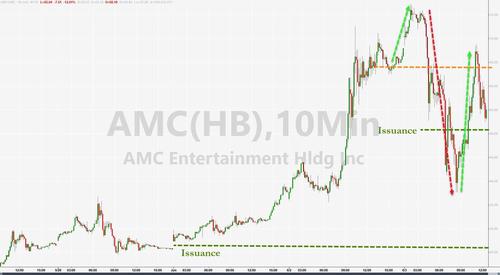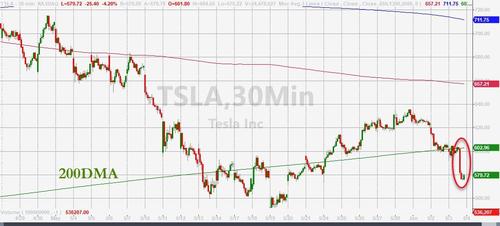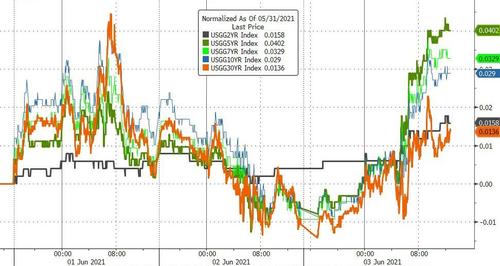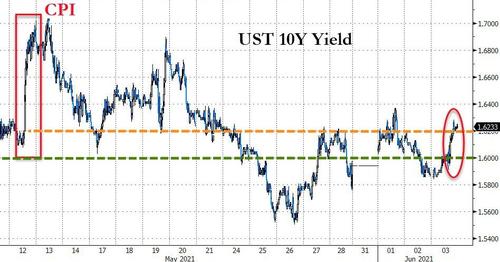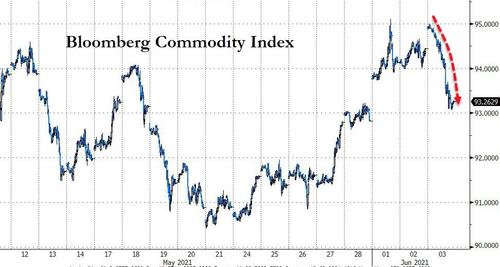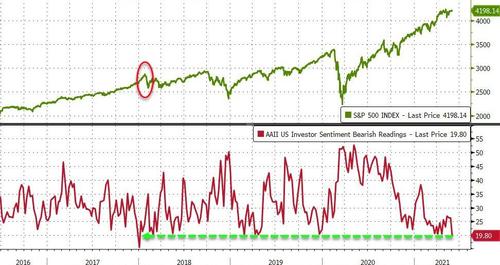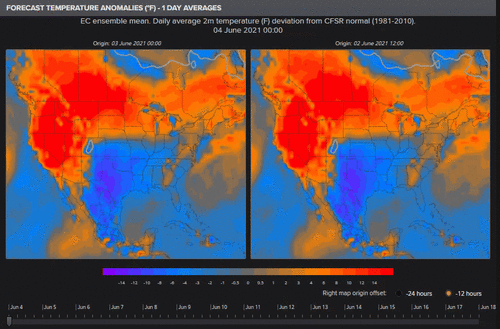Authored by Katherine Eban of Vanityfair.com,
Throughout 2020, the notion that the novel coronavirus leaked from a lab was off-limits. Those who dared to push for transparency say toxic politics and hidden agendas kept us in the dark…
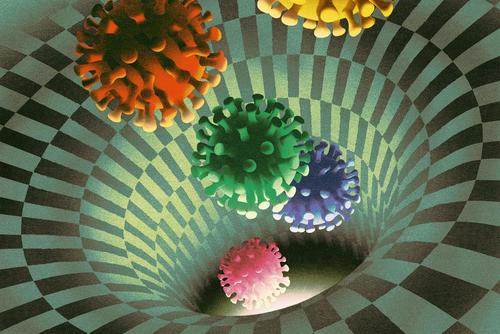
The Lab-Leak Theory: Inside the Fight to Uncover COVID-19’s Origins
I. A Group Called DRASTIC
Gilles Demaneuf is a data scientist with the Bank of New Zealand in Auckland. He was diagnosed with Asperger’s Syndrome ten years ago, and believes it gives him a professional advantage. “I’m very good at finding patterns in data, when other people see nothing,” he says.
Early last spring, as cities worldwide were shutting down to halt the spread of COVID-19, Demaneuf, 52, began reading up on the origins of SARS-CoV-2, the virus that causes the disease. The prevailing theory was that it had jumped from bats to some other species before making the leap to humans at a market in China, where some of the earliest cases appeared in late 2019. The Huanan wholesale market, in the city of Wuhan, is a complex of markets selling seafood, meat, fruit, and vegetables. A handful of vendors sold live wild animals—a possible source of the virus.
That wasn’t the only theory, though. Wuhan is also home to China’s foremost coronavirus research laboratory, housing one of the world’s largest collections of bat samples and bat-virus strains. The Wuhan Institute of Virology’s lead coronavirus researcher, Shi Zhengli, was among the first to identify horseshoe bats as the natural reservoirs for SARS-CoV, the virus that sparked an outbreak in 2002, killing 774 people and sickening more than 8,000 globally. After SARS, bats became a major subject of study for virologists around the world, and Shi became known in China as “Bat Woman” for her fearless exploration of their caves to collect samples. More recently, Shi and her colleagues at the WIV have performed high-profile experiments that made pathogens more infectious. Such research, known as “gain-of-function,” has generated heated controversy among virologists.
To some people, it seemed natural to ask whether the virus causing the global pandemic had somehow leaked from one of the WIV’s labs—a possibility Shi has strenuously denied.
On February 19, 2020, The Lancet, among the most respected and influential medical journals in the world, published a statement that roundly rejected the lab-leak hypothesis, effectively casting it as a xenophobic cousin to climate change denialism and anti-vaxxism. Signed by 27 scientists, the statement expressed “solidarity with all scientists and health professionals in China” and asserted: “We stand together to strongly condemn conspiracy theories suggesting that COVID-19 does not have a natural origin.”
The Lancet statement effectively ended the debate over COVID-19’s origins before it began. To Gilles Demaneuf, following along from the sidelines, it was as if it had been “nailed to the church doors,” establishing the natural origin theory as orthodoxy. “Everyone had to follow it. Everyone was intimidated. That set the tone.”
The statement struck Demaneuf as “totally nonscientific.” To him, it seemed to contain no evidence or information. And so he decided to begin his own inquiry in a “proper” way, with no idea of what he would find.
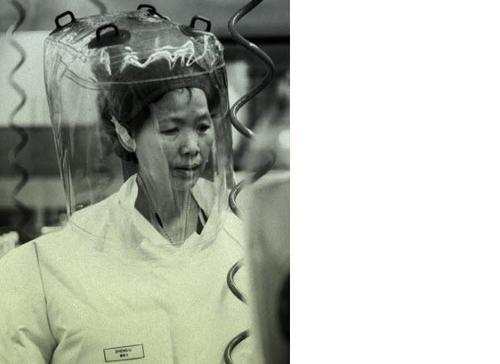
Shi Zhengli, the Wuhan Institute of Virology’s lead coronavirus researcher, is frequently pictured in a full-body positive-pressure suit, though not all the labs there require one.By JOHANNES EISELE/AFP/Getty Images.
Demaneuf began searching for patterns in the available data, and it wasn’t long before he spotted one. China’s laboratories were said to be airtight, with safety practices equivalent to those in the U.S. and other developed countries. But Demaneuf soon discovered that there had been four incidents of SARS-related lab breaches since 2004, two occuring at a top laboratory in Beijing. Due to overcrowding there, a live SARS virus that had been improperly deactivated, had been moved to a refrigerator in a corridor. A graduate student then examined it in the electron microscope room and sparked an outbreak.
Demaneuf published his findings in a Medium post, titled “The Good, the Bad and the Ugly: a review of SARS Lab Escapes.” By then, he had begun working with another armchair investigator, Rodolphe de Maistre. A laboratory project director based in Paris who had previously studied and worked in China, de Maistre was busy debunking the notion that the Wuhan Institute of Virology was a “laboratory” at all. In fact, the WIV housed numerous laboratories that worked on coronaviruses. Only one of them has the highest biosafety protocol: BSL-4, in which researchers must wear full-body pressurized suits with independent oxygen. Others are designated BSL-3 and even BSL-2, roughly as secure as an American dentist’s office.
Having connected online, Demaneuf and de Maistre began assembling a comprehensive list of research laboratories in China. As they posted their findings on Twitter, they were soon joined by others around the world. Some were cutting-edge scientists at prestigious research institutes. Others were science enthusiasts. Together, they formed a group called DRASTIC, short for Decentralized Radical Autonomous Search Team Investigating COVID-19. Their stated objective was to solve the riddle of COVID-19’s origin.
At times, it seemed the only other people entertaining the lab-leak theory were crackpots or political hacks hoping to wield COVID-19 as a cudgel against China. President Donald Trump’s former political adviser Steve Bannon, for instance, joined forces with an exiled Chinese billionaire named Guo Wengui to fuel claims that China had developed the disease as a bioweapon and purposefully unleashed it on the world. As proof, they paraded a Hong Kong scientist around right-wing media outlets until her manifest lack of expertise doomed the charade.
With disreputable wing nuts on one side of them and scornful experts on the other, the DRASTIC researchers often felt as if they were on their own in the wilderness, working on the world’s most urgent mystery. They weren’t alone. But investigators inside the U.S. government asking similar questions were operating in an environment that was as politicized and hostile to open inquiry as any Twitter echo chamber. When Trump himself floated the lab-leak hypothesis last April, his divisiveness and lack of credibility made things more, not less, challenging for those seeking the truth.
“The DRASTIC people are doing better research than the U.S. government,” says David Asher, a former senior investigator under contract to the State Department.
The question is: Why?
II. “A Can of Worms”
Since December 1, 2019, the SARS-CoV-2 virus that causes COVID-19 has infected more than 170 million people around the world and killed more than 3.5 million. To this day, we don’t know how or why this novel coronavirus suddenly appeared in the human population. Answering that question is more than an academic pursuit: Without knowing where it came from, we can’t be sure we’re taking the right steps to prevent a recurrence.
And yet, in the wake of the Lancet statement and under the cloud of Donald Trump’s toxic racism, which contributed to an alarming wave of anti-Asian violence in the U.S., one possible answer to this all-important question remained largely off-limits until the spring of 2021.
Behind closed doors, however, national security and public health experts and officials across a range of departments in the executive branch were locked in high-stakes battles over what could and couldn’t be investigated and made public.
A months long Vanity Fair investigation, interviews with more than 40 people, and a review of hundreds of pages of U.S. government documents, including internal memos, meeting minutes, and email correspondence, found that conflicts of interest, stemming in part from large government grants supporting controversial virology research, hampered the U.S. investigation into COVID-19’s origin at every step. In one State Department meeting, officials seeking to demand transparency from the Chinese government say they were explicitly told by colleagues not to explore the Wuhan Institute of Virology’s gain-of-function research, because it would bring unwelcome attention to U.S. government funding of it.
In an internal memo obtained by Vanity Fair, Thomas DiNanno, former acting assistant secretary of the State Department’s Bureau of Arms Control, Verification, and Compliance, wrote that staff from two bureaus, his own and the Bureau of International Security and Nonproliferation, “warned” leaders within his bureau “not to pursue an investigation into the origin of COVID-19” because it would “‘open a can of worms’ if it continued.”
There are reasons to doubt the lab-leak hypothesis. There is a long, well-documented history of natural spillovers leading to outbreaks, even when the initial and intermediate host animals have remained a mystery for months and years, and some expert virologists say the supposed oddities of the SARS-CoV-2 sequence have been found in nature.

Dr. Robert Redfield, former director of the CDC, said he received death threats from fellow scientists after telling CNN he thought the virus likely escaped from a lab. “I expected it from politicians. I didn’t expect it from science,” he said.By Andrew Harnik/Getty Images.
But for most of the past year, the lab-leak scenario was treated not simply as unlikely or even inaccurate but as morally out-of-bounds. In late March, former Centers for Disease Control director Robert Redfield received death threats from fellow scientists after telling CNN that he believed COVID-19 had originated in a lab. “I was threatened and ostracized because I proposed another hypothesis,” Redfield told Vanity Fair. “I expected it from politicians. I didn’t expect it from science.”
With President Trump out of office, it should be possible to reject his xenophobic agenda and still ask why, in all places in the world, did the outbreak begin in the city with a laboratory housing one of the world’s most extensive collection of bat viruses, doing some of the most aggressive research?
Dr. Richard Ebright, board of governors professor of chemistry and chemical biology at Rutgers University, said that from the very first reports of a novel bat-related coronavirus outbreak in Wuhan, it took him “a nanosecond or a picosecond” to consider a link to the Wuhan Institute of Virology. Only two other labs in the world, in Galveston, Texas, and Chapel Hill, North Carolina, were doing similar research. “It’s not a dozen cities,” he said. “It’s three places.”
Then came the revelation that the Lancet statement was not only signed but organized by a zoologist named Peter Daszak, who has repackaged U.S. government grants and allocated them to facilities conducting gain-of-function research—among them the WIV itself. David Asher, now a senior fellow at the Hudson Institute, ran the State Department’s day-to-day COVID-19 origins inquiry. He said it soon became clear that “there is a huge gain-of-function bureaucracy” inside the federal government.
As months go by without a host animal that proves the natural theory, the questions from credible doubters have gained in urgency. To one former federal health official, the situation boiled down to this: An institute “funded by American dollars is trying to teach a bat virus to infect human cells, then there is a virus” in the same city as that lab. It is “not being intellectually honest not to consider the hypothesis” of a lab escape.
And given how aggressively China blocked efforts at a transparent investigation, and in light of its government’s own history of lying, obfuscating, and crushing dissent, it’s fair to ask if Shi Zhengli, the Wuhan Institute’s lead coronavirus researcher, would be at liberty to report a leak from her lab even if she’d wanted to.
On May 26, the steady crescendo of questions led President Joe Biden to release a statement acknowledging that the intelligence community had “coalesced around two likely scenarios,” and announce that he had asked for a more definitive conclusion within 90 days. His statement noted, “The failure to get our inspectors on the ground in those early months will always hamper any investigation into the origin of COVID-19.” But that wasn’t the only failure.
In the words of David Feith, former deputy assistant secretary of state in the East Asia bureau, “The story of why parts of the U.S. government were not as curious as many of us think they should have been is a hugely important one.”
III. “Smelled Like a Cover-Up”
On December 9, 2020, roughly a dozen State Department employees from four different bureaus gathered in a conference room in Foggy Bottom to discuss an upcoming fact-finding mission to Wuhan organized in part by the World Health Organization. The group agreed on the need to press China to allow a thorough, credible, and transparent investigation, with unfettered access to markets, hospitals, and government laboratories. The conversation then turned to the more sensitive question: What should the U.S. government say publicly about the Wuhan Institute of Virology?
A small group within the State Department’s Arms Control, Verification, and Compliance bureau had been studying the Institute for months. The group had recently acquired classified intelligence suggesting that three WIV researchers conducting gain-of-function experiments on coronavirus samples had fallen ill in the autumn of 2019, before the COVID-19 outbreak was known to have started.
As officials at the meeting discussed what they could share with the public, they were advised by Christopher Park, the director of the State Department’s Biological Policy Staff in the Bureau of International Security and Nonproliferation, not to say anything that would point to the U.S. government’s own role in gain-of-function research, according to documentation of the meeting obtained by Vanity Fair.
Some of the attendees were “absolutely floored,” said an official familiar with the proceedings. That someone in the U.S. government could “make an argument that is so nakedly against transparency, in light of the unfolding catastrophe, was…shocking and disturbing.”
Park, who in 2017 had been involved in lifting a U.S. government moratorium on funding for gain-of-function research, was not the only official to warn the State Department investigators against digging in sensitive places. As the group probed the lab-leak scenario, among other possibilities, its members were repeatedly advised not to open a “Pandora’s box,” said four former State Department officials interviewed by Vanity Fair. The admonitions “smelled like a cover-up,” said Thomas DiNanno, “and I wasn’t going to be part of it.”
Reached for comment, Chris Park told Vanity Fair, “I am skeptical that people genuinely felt they were being discouraged from presenting facts.” He added that he was simply arguing that it “is making an enormous and unjustifiable leap…to suggest that research of that kind [meant] that something untoward is going on.”
IV. An “Antibody Response”
There were two main teams inside the U.S. government working to uncover the origins of COVID-19: one in the State Department and another under the direction of the National Security Council. No one at the State Department had much interest in Wuhan’s laboratories at the start of the pandemic, but they were gravely concerned with China’s apparent cover-up of the outbreak’s severity. The government had shut down the Huanan market, ordered laboratory samples destroyed, claimed the right to review any scientific research about COVID-19 ahead of publication, and expelled a team of Wall Street Journal reporters.
In January 2020, a Wuhan ophthalmologist named Li Wenliang, who’d tried to warn his colleagues that the pneumonia could be a form of SARS was arrested, accused of disrupting the social order, and forced to write a self-criticism. He died of COVID-19 in February, lionized by the Chinese public as a hero and whistleblower.
“You had Chinese [government] coercion and suppression,” said David Feith of the State Department’s East Asia bureau. “We were very concerned that they were covering it up and whether the information coming to the World Health Organization was reliable.”
As questions swirled, Miles Yu, the State Department’s principal China strategist, noted that the WIV had remained largely silent. Yu, who is fluent in Mandarin, began mirroring its website and compiling a dossier of questions about its research. In April, he gave his dossier to Secretary of State Pompeo, who in turn publicly demanded access to the laboratories there.
It is not clear whether Yu’s dossier made its way to President Trump. But on April 30, 2020, the Office of the Director of National Intelligence put out an ambiguous statement whose apparent goal was to suppress a growing furor around the lab-leak theory. It said that the intelligence community “concurs with the wide scientific consensus that the COVID-19 virus was not manmade or genetically modified” but would continue to assess “whether the outbreak began through contact with infected animals or if it was the result of an accident at a laboratory in Wuhan.”
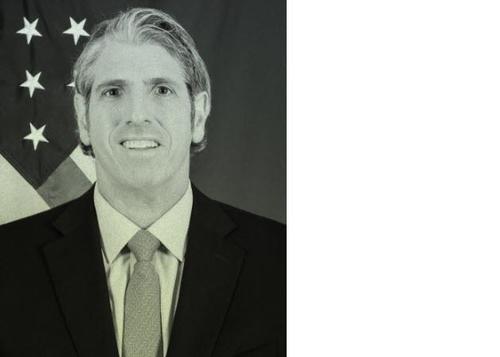
State Department official Thomas DiNanno wrote a memo charging that staff from his bureau were “warned…not to pursue an investigation into the origin of COVID-19” because it would “‘open a can of worms’ if it continued.”SOURCE: U.S. DEPARTMENT OF STATE
“It was pure panic,” said former deputy national security adviser Matthew Pottinger. “They were getting flooded with queries. Someone made the unfortunate decision to say, ‘We basically know nothing, so let’s put out the statement.’”
Then, the bomb-thrower-in-chief weighed in. At a press briefing just hours later, Trump contradicted his own intelligence officials and claimed that he had seen classified information indicating that the virus had come from the Wuhan Institute of Virology. Asked what the evidence was, he said, “I can’t tell you that. I’m not allowed to tell you that.”
Trump’s premature statement poisoned the waters for anyone seeking an honest answer to the question of where COVID-19 came from. According to Pottinger, there was an “antibody response” within the government, in which any discussion of a possible lab origin was linked to destructive nativist posturing.
The revulsion extended to the international science community, whose “maddening silence” frustrated Miles Yu. He recalled, “Anyone who dares speak out would be ostracized.”
V. “Too Risky to Pursue”
The idea of a lab leak first came to NSC officials not from hawkish Trumpists but from Chinese social media users, who began sharing their suspicions as early as January 2020. Then, in February, a research paper coauthored by two Chinese scientists, based at separate Wuhan universities, appeared online as a preprint. It tackled a fundamental question: How did a novel bat coronavirus get to a major metropolis of 11 million people in central China, in the dead of winter when most bats were hibernating, and turn a market where bats weren’t sold into the epicenter of an outbreak?
The paper offered an answer: “We screened the area around the seafood market and identified two laboratories conducting research on bat coronavirus.” The first was the Wuhan Center for Disease Control and Prevention, which sat just 280 meters from the Huanan market and had been known to collect hundreds of bat samples. The second, the researchers wrote, was the Wuhan Institute of Virology.
The paper came to a staggeringly blunt conclusion about COVID-19: “the killer coronavirus probably originated from a laboratory in Wuhan…. Regulations may be taken to relocate these laboratories far away from city center and other densely populated places.” Almost as soon as the paper appeared on the internet, it disappeared, but not before U.S. government officials took note.
By then, Matthew Pottinger had approved a COVID-19 origins team, run by the NSC directorate that oversaw issues related to weapons of mass destruction. A longtime Asia expert and former journalist, Pottinger purposefully kept the team small, because there were so many people within the government “wholly discounting the possibility of a lab leak, who were predisposed that it was impossible,” said Pottinger. In addition, many leading experts had either received or approved funding for gain-of-function research. Their “conflicted” status, said Pottinger, “played a profound role in muddying the waters and contaminating the shot at having an impartial inquiry.”
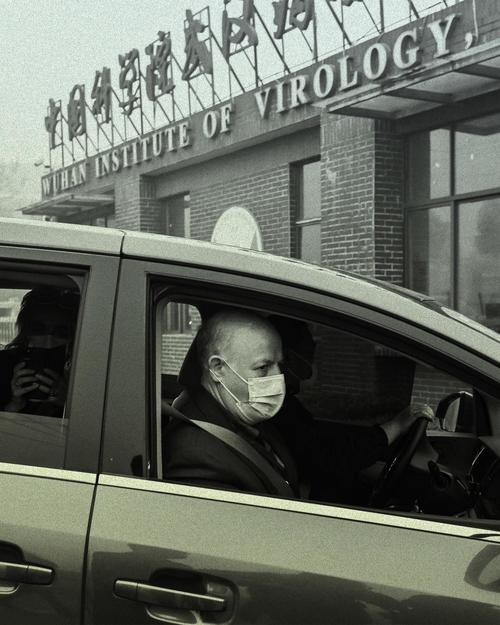
Peter Daszak, who repackaged U.S. government grants and allocated the funds to research institutes including the WIV, arrives there on February 3, 2021, during a fact-finding mission organized in part by the World Health Organization.By Hector RETAMAL/AFP/Getty Images.
As they combed open sources as well as classified information, the team’s members soon stumbled on a 2015 research paper by Shi Zhengli and the University of North Carolina epidemiologist Ralph Baric proving that the spike protein of a novel coronavirus could infect human cells. Using mice as subjects, they inserted the protein from a Chinese rufous horseshoe bat into the molecular structure of the SARS virus from 2002, creating a new, infectious pathogen.
This gain-of-function experiment was so fraught that the authors flagged the danger themselves, writing, “scientific review panels may deem similar studies…too risky to pursue.” In fact, the study was intended to raise an alarm and warn the world of “a potential risk of SARS-CoV re-emergence from viruses currently circulating in bat populations.” The paper’s acknowledgments cited funding from the U.S. National Institutes of Health and from a nonprofit called EcoHealth Alliance, which had parceled out grant money from the U.S. Agency for International Development. EcoHealth Alliance is run by Peter Daszak, the zoologist who helped organize the Lancet statement.
That a genetically engineered virus might have escaped from the WIV was one alarming scenario. But it was also possible that a research trip to collect bat samples could have led to infection in the field, or back at the lab.
The NSC investigators found ready evidence that China’s labs were not as safe as advertised. Shi Zhengli herself had publicly acknowledged that, until the pandemic, all of her team’s coronavirus research—some involving live SARS-like viruses—had been conducted in less secure BSL-3 and even BSL-2 laboratories.
In 2018, a delegation of American diplomats visited the WIV for the opening of its BSL-4 laboratory, a major event. In an unclassified cable, as a Washington Post columnist reported, they wrote that a shortage of highly trained technicians and clear protocols threatened the facility’s safe operations. The issues had not stopped the WIV’s leadership from declaring the lab “ready for research on class-four pathogens (P4), among which are the most virulent viruses that pose a high risk of aerosolized person-to-person transmission.”

Click to see the full document
On February 14, 2020, to the surprise of NSC officials, President Xi Jinping of China announced a plan to fast-track a new biosecurity law to tighten safety procedures throughout the country’s laboratories. Was this a response to confidential information? “In the early weeks of the pandemic, it didn’t seem crazy to wonder if this thing came out of a lab,” Pottinger reflected.
Apparently, it didn’t seem crazy to Shi Zhengli either. A Scientific American article first published in March 2020, for which she was interviewed, described how her lab had been the first to sequence the virus in those terrible first weeks. It also recounted how:
[S]he frantically went through her own lab’s records from the past few years to check for any mishandling of experimental materials, especially during disposal. Shi breathed a sigh of relief when the results came back: none of the sequences matched those of the viruses her team had sampled from bat caves. “That really took a load off my mind,” she says. “I had not slept a wink for days.”
As the NSC tracked these disparate clues, U.S. government virologists advising them flagged one study first submitted in April 2020. Eleven of its 23 coauthors worked for the Academy of Military Medical Sciences, the Chinese army’s medical research institute. Using the gene-editing technology known as CRISPR, the researchers had engineered mice with humanized lungs, then studied their susceptibility to SARS-CoV-2. As the NSC officials worked backward from the date of publication to establish a timeline for the study, it became clear that the mice had been engineered sometime in the summer of 2019, before the pandemic even started. The NSC officials were left wondering: Had the Chinese military been running viruses through humanized mouse models, to see which might be infectious to humans?
Believing they had uncovered important evidence in favor of the lab-leak hypothesis, the NSC investigators began reaching out to other agencies. That’s when the hammer came down. “We were dismissed,” said Anthony Ruggiero, the NSC’s senior director for counterproliferation and biodefense. “The response was very negative.”
VI. Sticklers for Accuracy
By the summer of 2020, Gilles Demaneuf was spending up to four hours a day researching the origins of COVID-19, joining Zoom meetings before dawn with European collaborators and not sleeping much. He began to receive anonymous calls and notice strange activity on his computer, which he attributed to Chinese government surveillance. “We are being monitored for sure,” he says. He moved his work to the encrypted platforms Signal and ProtonMail.
As they posted their findings, the DRASTIC researchers attracted new allies. Among the most prominent was Jamie Metzl, who launched a blog on April 16 that became a go-to site for government researchers and journalists examining the lab-leak hypothesis. A former executive vice president of the Asia Society, Metzl sits on the World Health Organization’s advisory committee on human genome editing and served in the Clinton administration as the NSC’s director for multilateral affairs. In his first post on the subject, he made clear that he had no definitive proof and believed that Chinese researchers at the WIV had the “best intentions.” Metzl also noted, “In no way do I seek to support or align myself with any activities that may be considered unfair, dishonest, nationalistic, racist, bigoted, or biased in any way.”
On December 11, 2020, Demaneuf—a stickler for accuracy—reached out to Metzl to alert him to a mistake on his blog. The 2004 SARS lab escape in Beijing, Demaneuf pointed out, had led to 11 infections, not four. Demaneuf was “impressed” by Metzl’s immediate willingness to correct the information. “From that time, we started working together.”
Metzl, in turn, was in touch with the Paris Group, a collective of more than 30 skeptical scientific experts who met by Zoom once a month for hours-long meetings to hash out emerging clues. Before joining the Paris Group, Dr. Filippa Lentzos, a biosecurity expert at King’s College London, had pushed back online against wild conspiracies. No, COVID-19 was not a bioweapon used by the Chinese to infect American athletes at the Military World Games in Wuhan in October 2019. But the more she researched, the more concerned she became that not every possibility was being explored. On May 1, 2020, she published a careful assessment in the Bulletin of the Atomic Scientists describing just how a pathogen could have escaped the Wuhan Institute of Virology. She noted that a September 2019 paper in an academic journal by the director of the WIV’s BSL-4 laboratory, Yuan Zhiming, had outlined safety deficiencies in China’s labs. “Maintenance cost is generally neglected,” he had written. “Some BSL-3 laboratories run on extremely minimal operational costs or in some cases none at all.”
Alina Chan, a young molecular biologist and postdoctoral fellow at the Broad Institute of MIT and Harvard University, found that early sequences of the virus showed very little evidence of mutation. Had the virus jumped from animals to humans, one would expect to see numerous adaptations, as was true in the 2002 SARS outbreak. To Chan, it appeared that SARS-CoV-2 was already “pre-adapted to human transmission,” she wrote in a preprint paper in May 2020.
But perhaps the most startling find was made by an anonymous DRASTIC researcher, known on Twitter as @TheSeeker268. The Seeker, as it turns out, is a young former science teacher from Eastern India. He had begun plugging keywords into the China National Knowledge Infrastructure, a website that houses papers from 2,000 Chinese journals, and running the results through Google Translate.
One day last May, he fished up a thesis from 2013 written by a master’s student in Kunming, China. The thesis opened an extraordinary window into a bat-filled mine shaft in Yunnan province and raised sharp questions about what Shi Zhengli had failed to mention in the course of making her denials.
VII. The Mojiang Miners
In 2012, six miners in the lush mountains of Mojiang county in southern Yunnan province were assigned an unenviable task: to shovel out a thick carpet of bat feces from the floor of a mine shaft. After weeks of dredging up bat guano, the miners became gravely ill and were sent to the First Affiliated Hospital at the Kunming Medical University in Yunnan’s capital. Their symptoms of cough, fever, and labored breathing rang alarm bells in a country that had suffered through a viral SARS outbreak a decade earlier.
The hospital called in a pulmonologist, Zhong Nanshan, who had played a prominent role in treating SARS patients and would go on to lead an expert panel for China’s National Health Commission on COVID-19. Zhong, according to the 2013 master’s thesis, immediately suspected a viral infection. He recommended a throat culture and an antibody test, but he also asked what kind of bat had produced the guano. The answer: the rufous horseshoe bat, the same species implicated in the first SARS outbreak.
Within months, three of the six miners were dead. The eldest, who was 63, died first. “The disease was acute and fierce,” the thesis noted. It concluded: “the bat that caused the six patients to fall ill was the Chinese rufous horseshoe bat.” Blood samples were sent to the Wuhan Institute of Virology, which found that they were positive for SARS antibodies, a later Chinese dissertation documented.
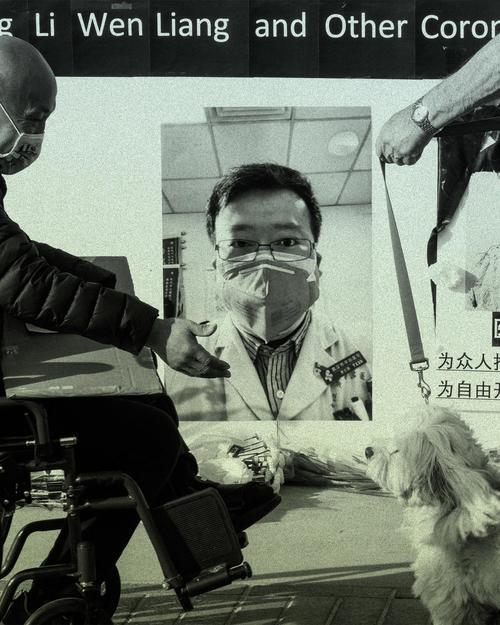
A memorial for Dr. Li Wenliang, who was celebrated as a whistleblower in China after sounding the alarm about COVID-19 in January 2020. He later died of the disease.By Mark RALSTON/AFP/Getty Images.
But there was a mystery at the heart of the diagnosis. Bat coronaviruses were not known to harm humans. What was so different about the strains from inside the cave? To find out, teams of researchers from across China and beyond traveled to the abandoned mine shaft to collect viral samples from bats, musk shrews, and rats.
In an October 2013 Nature study, Shi Zhengli reported a key discovery: that certain bat viruses could potentially infect humans without first jumping to an intermediate animal. By isolating a live SARS-like bat coronavirus for the first time, her team had found that it could enter human cells through a protein called the ACE2 receptor.
In subsequent studies in 2014 and 2016, Shi and her colleagues continued studying samples of bat viruses collected from the mine shaft, hoping to figure out which one had infected the miners. The bats were bristling with multiple coronaviruses. But there was only one whose genome closely resembled SARS. The researchers named it RaBtCoV/4991.
On February 3, 2020, with the COVID-19 outbreak already spreading beyond China, Shi Zhengli and several colleagues published a paper noting that the SARS-CoV-2 virus’s genetic code was almost 80% identical to that of SARS-CoV, which caused the 2002 outbreak. But they also reported that it was 96.2% identical to a coronavirus sequence in their possession called RaTG13, which was previously detected in “Yunnan province.” They concluded that RaTG13 was the closest known relative to SARS-CoV-2.
In the following months, as researchers around the world hunted for any known bat virus that might be a progenitor of SARS-CoV-2, Shi Zhengli offered shifting and sometimes contradictory accounts of where RaTG13 had come from and when it was fully sequenced. Searching a publicly available library of genetic sequences, several teams, including a group of DRASTIC researchers, soon realized that RaTG13 appeared identical to RaBtCoV/4991—the virus from the cave where the miners fell ill in 2012 with what looked like COVID-19.
In July, as questions mounted, Shi Zhengli told Science magazine that her lab had renamed the sample for clarity. But to skeptics, the renaming exercise looked like an effort to hide the sample’s connection to the Mojiang mine.
Their questions multiplied the following month when Shi, Daszak, and their colleagues published an account of 630 novel coronaviruses they had sampled between 2010 and 2015. Combing through the supplementary data, DRASTIC researchers were stunned to find eight more viruses from the Mojiang mine that were closely related to RaTG13 but had not been flagged in the account. Alina Chan of the Broad Institute said it was “mind-boggling” that these crucial puzzle pieces had been buried without comment.
In October 2020, as questions about the Mojiang mine shaft intensified, a team of journalists from the BBC tried to access the mine itself. They were tailed by plainclothes police officers and found the road conveniently blocked by a broken-down truck.
Shi, by now facing growing scrutiny from the international press corps, told the BBC: “I’ve just downloaded the Kunming Hospital University’s student’s master’s thesis and read it…. The conclusion is neither based on evidence nor logic. But it’s used by conspiracy theorists to doubt me. If you were me, what would you do?”
VIII. The Gain-of-Function Debate
On January 3, 2020, Dr. Robert Redfield, director of the U.S. Centers for Disease Control and Prevention, got a phone call from his counterpart Dr. George Fu Gao, head of the Chinese Center for Disease Control and Prevention. Gao described the appearance of a mysterious new pneumonia, apparently limited to people exposed at a market in Wuhan. Redfield immediately offered to send a team of specialists to help investigate.
But when Redfield saw the breakdown of early cases, some of which were family clusters, the market explanation made less sense. Had multiple family members gotten sick via contact with the same animal? Gao assured him there was no human-to-human transmission, says Redfield, who nevertheless urged him to test more widely in the community. That effort prompted a tearful return call. Many cases had nothing to do with the market, Gao admitted. The virus appeared to be jumping from person to person, a far scarier scenario.

Former deputy national security adviser Matthew Pottinger said the “conflicted” status of leading experts who had either approved or received funding for gain-of-function research “played a profound role in muddying the waters and contaminating the shot at having an impartial inquiry.”By Jabin Botsford/The Washington Post/Getty Images.
Redfield immediately thought of the Wuhan Institute of Virology. A team could rule it out as a source of the outbreak in just a few weeks, by testing researchers there for antibodies. Redfield formally reiterated his offer to send specialists, but Chinese officials didn’t respond to his overture.
Redfield, a virologist by training, was suspicious of the WIV in part because he’d been steeped in the yearslong battle over gain-of-function research. The debate engulfed the virology community in 2011, after Ron Fouchier, a researcher at the Erasmus Medical Center in Rotterdam, announced that he had genetically altered the H5N1 avian influenza strain to make it transmissible among ferrets, who are genetically closer to humans than mice. Fouchier calmly declared that he’d produced “probably one of the most dangerous viruses you could make.”
In the ensuing uproar, scientists battled over the risks and benefits of such research. Those in favor claimed it could help prevent pandemics, by highlighting potential risks and accelerating vaccine development. Critics argued that creating pathogens that didn’t exist in nature ran the risk of unleashing them.
In October 2014, the Obama administration imposed a moratorium on new funding for gain-of-function research projects that could make influenza, MERS, or SARS viruses more virulent or transmissible. But a footnote to the statement announcing the moratorium carved out an exception for cases deemed “urgently necessary to protect the public health or national security.”
In the first year of the Trump administration, the moratorium was lifted and replaced with a review system called the HHS P3CO Framework (for Potential Pandemic Pathogen Care and Oversight). It put the onus for ensuring the safety of any such research on the federal department or agency funding it. This left the review process shrouded in secrecy. “The names of reviewers are not released, and the details of the experiments to be considered are largely secret,” said the Harvard epidemiologist Dr. Marc Lipsitch, whose advocacy against gain-of-function research helped prompt the moratorium. (An NIH spokesperson told Vanity Fair that “information about individual unfunded applications is not public to preserve confidentiality and protect sensitive information, preliminary data, and intellectual property.”)
Inside the NIH, which funded such research, the P3CO framework was largely met with shrugs and eye rolls, said a longtime agency official: “If you ban gain-of-function research, you ban all of virology.” He added, “Ever since the moratorium, everyone’s gone wink-wink and just done gain-of-function research anyway.”
British-born Peter Daszak, 55, is the president of EcoHealth Alliance, a New York City–based nonprofit with the laudable goal of preventing the outbreak of emerging diseases by safeguarding ecosystems. In May 2014, five months before the moratorium on gain-of-function research was announced, EcoHealth secured a NIAID grant of roughly $3.7 million, which it allocated in part to various entities engaged in collecting bat samples, building models, and performing gain-of-function experiments to see which animal viruses were able to jump to humans. The grant was not halted under the moratorium or the P3CO framework.
By 2018, EcoHealth Alliance was pulling in up to $15 million a year in grant money from an array of federal agencies, including the Defense Department, the Department of Homeland Security, and the U.S. Agency for International Development, according to 990 tax exemption forms it filed with the New York State Attorney General’s Charities Bureau. Shi Zhengli herself listed U.S. government grant support of more than $1.2 million on her curriculum vitae: $665,000 from the NIH between 2014 and 2019; and $559,500 over the same period from USAID. At least some of those funds were routed through EcoHealth Alliance.
EcoHealth Alliance’s practice of divvying up large government grants into smaller sub-grants for individual labs and institutions gave it enormous sway within the field of virology. The sums at stake allow it to “purchase a lot of omertà” from the labs it supports, said Richard Ebright of Rutgers. (In response to detailed questions, an EcoHealth Alliance spokesperson said on behalf of the organization and Daszak, “We have no comment.”)
As the pandemic raged, the collaboration between EcoHealth Alliance and the WIV wound up in the crosshairs of the Trump administration. At a White House COVID-19 press briefing on April 17, 2020, a reporter from the conspiratorial right-wing media outlet Newsmax asked Trump a factually inaccurate question about a $3.7 million NIH grant to a level-four lab in China. “Why would the U.S. give a grant like that to China?” the reporter asked.
Trump responded, “We will end that grant very quickly,” adding, “Who was president then, I wonder.”
A week later, an NIH official notified Daszak in writing that his grant had been terminated. The order had come from the White House, Dr. Anthony Fauci later testified before a congressional committee. The decision fueled a firestorm: 81 Nobel Laureates in science denounced the decision in an open letter to Trump health officials, and 60 Minutes ran a segment focused on the Trump administration’s shortsighted politicization of science.
Daszak appeared to be the victim of a political hit job, orchestrated to blame China, Dr. Fauci, and scientists in general for the pandemic, while distracting from the Trump administration’s bungled response. “He’s basically a wonderful, decent human being” and an “old-fashioned altruist,” said the NIH official. “To see this happening to him, it really kills me.”
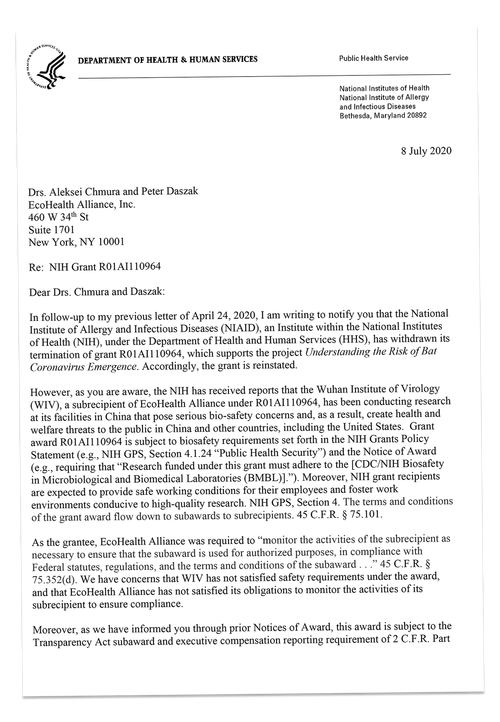
Click to see the full document Lauer, Michael (NIH/OD) [E]
In July, the NIH attempted to backtrack. It reinstated the grant but suspended its research activities until EcoHealth Alliance fulfilled seven conditions, some of which went beyond the nonprofit’s purview and seemed to stray into tinfoil-hat territory. They included: providing information on the “apparent disappearance” of a Wuhan Institute of Virology researcher, who was rumored on social media to be patient zero, and explaining diminished cell phone traffic and roadblocks around the WIV in October 2019.
But conspiracy-minded conservatives weren’t the only ones looking askance at Daszak. Ebright likened Daszak’s model of research—bringing samples from a remote area to an urban one, then sequencing and growing viruses and attempting to genetically modify them to make them more virulent—to “looking for a gas leak with a lighted match.” Moreover, Ebright believed that Daszak’s research had failed in its stated purpose of predicting and preventing pandemics through its global collaborations.
It soon emerged, based on emails obtained by a Freedom of Information group called U.S. Right to Know, that Daszak had not only signed but organized the influential Lancet statement, with the intention of concealing his role and creating the impression of scientific unanimity.
Under the subject line, “No need for you to sign the “Statement” Ralph!!,” he wrote to two scientists, including UNC’s Dr. Ralph Baric, who had collaborated with Shi Zhengli on the gain-of-function study that created a coronavirus capable of infecting human cells: “you, me and him should not sign this statement, so it has some distance from us and therefore doesn’t work in a counterproductive way.” Daszak added, “We’ll then put it out in a way that doesn’t link it back to our collaboration so we maximize an independent voice.”
Baric agreed, writing back, “Otherwise it looks self-serving and we lose impact.”
Baric did not sign the statement. In the end, Daszak did. At least six other signers had either worked at, or had been funded by, EcoHealth Alliance. The statement ended with a declaration of objectivity: “We declare no competing interests.”
Daszak mobilized so quickly for a reason, said Jamie Metzl: “If zoonosis was the origin, it was a validation…of his life work…. But if the pandemic started as part of a lab leak, it had the potential to do to virology what Three Mile Island and Chernobyl did to nuclear science.” It could mire the field indefinitely in moratoriums and funding restrictions.
IX. Dueling Memos
By the summer of 2020, the State Department’s COVID-19 origins investigation had gone cold. Officials in the Bureau of Arms Control, Verification, and Compliance went back to their normal work: surveilling the world for biological threats. “We weren’t looking for Wuhan,” said Thomas DiNanno. That fall, the State Department team got a tip from a foreign source: Key information was likely sitting in the U.S. intelligence community’s own files, unanalyzed. In November, that lead turned up classified information that was “absolutely arresting and shocking,” said a former State Department official. Three researchers at the Wuhan Institute of Virology, all connected with gain-of-function research on coronaviruses, had fallen ill in November 2019 and appeared to have visited the hospital with symptoms similar to COVID-19, three government officials told Vanity Fair.
While it is not clear what had sickened them, “these were not the janitors,” said the former State Department official. “They were active researchers. The dates were among the absolute most arresting part of the picture, because they are smack where they would be if this was the origin.” The reaction inside the State Department was, “Holy shit,” one former senior official recalled. “We should probably tell our bosses.” The investigation roared back to life.
An intelligence analyst working with David Asher sifted through classified channels and turned up a report that outlined why the lab-leak hypothesis was plausible. It had been written in May by researchers at the Lawrence Livermore National Laboratory, which performs national security research for the Department of Energy. But it appeared to have been buried within the classified collections system.

Jamie Metzl’s blog became a go-to site for government researchers and journalists examining the lab-leak hypothesis. In his first post on the subject, he wrote, “In no way do I seek to support or align myself with any activities that may be considered unfair, dishonest, nationalistic, racist, bigoted, or biased in any way.”By Alex Wong/Getty Images.
Now the officials were beginning to suspect that someone was actually hiding materials supportive of a lab-leak explanation. “Why did my contractor have to pore through documents?” DiNanno wondered. Their suspicion intensified when Department of Energy officials overseeing the Lawrence Livermore lab unsuccessfully tried to block the State Department investigators from talking to the report’s authors.
Their frustration crested in December, when they finally briefed Chris Ford, acting undersecretary for Arms Control and International Security. He seemed so hostile to their probe that they viewed him as a blinkered functionary bent on whitewashing China’s malfeasance. But Ford, who had years of experience in nuclear nonproliferation, had long been a China hawk. Ford told Vanity Fair that he saw his job as protecting the integrity of any inquiry into COVID-19’s origins that fell under his purview. Going with “stuff that makes us look like the crackpot brigade” would backfire, he believed.
There was another reason for his hostility. He’d already heard about the investigation from interagency colleagues, rather than from the team itself, and the secrecy left him with a “spidey sense” that the process was a form of “creepy freelancing.” He wondered: Had someone launched an unaccountable investigation with the goal of achieving a desired result?
He was not the only one with concerns. As one senior government official with knowledge of the State Department’s investigation said, “They were writing this for certain customers in the Trump administration. We asked for the reporting behind the statements that were made. It took forever. Then you’d read the report, it would have this reference to a tweet and a date. It was not something you could go back and find.”
After listening to the investigators’ findings, a technical expert in one of the State Department’s bioweapons offices “thought they were bonkers,” Ford recalled.
The State Department team, for its part, believed that Ford was the one trying to impose a preconceived conclusion: that COVID-19 had a natural origin. A week later, one of them attended the meeting where Christopher Park, who worked under Ford, advised those present not to draw attention to U.S. funding of gain-of-function research.
With deep distrust simmering, the State Department team convened a panel of experts to confidentially “red team” the lab-leak hypothesis. The idea was to pummel the theory and see if it still stood. The panel took place on the evening of January 7, one day after the insurrection at the Capitol. By then, Ford had announced his plan to resign.
Twenty-nine people logged on to a secure State Department video call that lasted three hours, according to meeting minutes obtained by Vanity Fair. The scientific experts included Ralph Baric, Alina Chan, and the Stanford microbiologist David Relman.
Asher invited Dr. Steven Quay, a breast cancer specialist who’d founded a biopharmaceutical company, to present a statistical analysis weighing the probability of a lab origin versus a natural one. Scissoring Quay’s analysis, Baric noted that its calculations failed to account for the millions of bat sequences that exist in nature but remain unknown. When a State Department adviser asked Quay whether he’d ever done a similar analysis, he replied there’s “a first time for everything,” according to the meeting minutes.
Though they questioned Quay’s findings, the scientists saw other reasons to suspect a lab origin. Part of the WIV’s mission was to sample the natural world and provide early warnings of “human capable viruses,” said Relman. The 2012 infections of six miners was “worthy of banner headlines at the time.” Yet those cases had never been reported to the WHO.
Baric added that, if SARS-CoV-2 had come from a “strong animal reservoir,” one might have expected to see “multiple introduction events,” rather than a single outbreak, though he cautioned that it didn’t prove “[this] was an escape from a laboratory.” That prompted Asher to ask, “Could this not have been partially bioengineered?”
Ford was so troubled by what he viewed as the panel’s weak evidence, and the secretive inquiry that preceded it, that he stayed up all night summarizing his concerns in a four-page memo. After saving it as a PDF so it couldn’t be altered, he emailed the memo to multiple State Department officials the next morning.
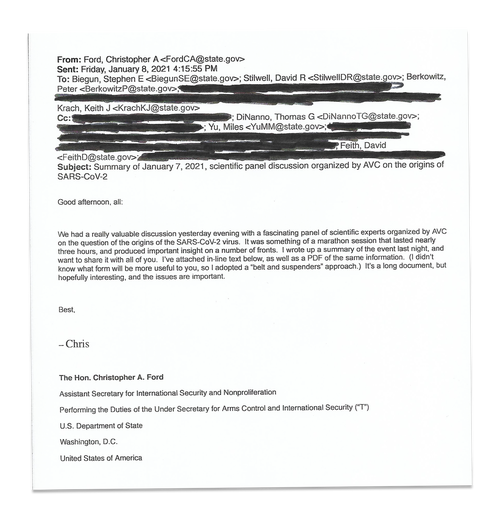
Click to see the full document
In the memo, Ford criticized the panel’s “lack of data” and added, “I would also caution you against suggesting that there is anything inherently suspicious—and suggestive of biological warfare activity—about People’s Liberation Army (PLA) involvement at WIV on classified projects. [I]t would be difficult to say that military involvement in classified virus research is intrinsically problematic, since the U.S. Army has been deeply involved in virus research in the United States for many years.”

Click to see the full document
Thomas DiNanno sent back a five-page rebuttal to Ford’s memo the next day, January 9 (though it was mistakenly dated “12/9/21”). He accused Ford of misrepresenting the panel’s efforts and enumerated the obstacles his team had faced: “apprehension and contempt” from the technical staff; warnings not to investigate the origins of COVID-19 for fear of opening a “can of worms”; and a “complete lack of responses to briefings and presentations.” He added that Quay had been invited only after the National Intelligence Council failed to provide statistical help.
A year’s worth of mutual suspicions had finally spilled out into dueling memos.
The State Department investigators pushed on, determined to go public with their concerns. They continued a weeks-long effort to declassify information that had been vetted by the intelligence community. On January 15, five days before President Joe Biden’s swearing in, the State Department released a fact sheet about activity at the Wuhan Institute of Virology, disclosing key information: that several researchers there had fallen ill with COVID-19-like symptoms in autumn 2019, before the first identified outbreak case; and that researchers there had collaborated on secret projects with China’s military and “engaged in classified research, including laboratory animal experiments, on behalf of the Chinese military since at least 2017.”
The statement withstood “aggressive suspicion,” as one former State Department official said, and the Biden administration has not walked it back. “I was very pleased to see Pompeo’s statement come through,” said Chris Ford. “I was so relieved that they were using real reporting that had been vetted and cleared.”
X. A Fact-Finding Mission to Wuhan
In early July, the World Health Organization invited the U.S. government to recommend experts for a fact-finding mission to Wuhan, a sign of progress in the long-delayed probe of COVID-19’s origins. Questions about the WHO’s independence from China, the country’s secrecy, and the raging pandemic had turned the anticipated mission into a minefield of international grudges and suspicion.
Within weeks, the U.S. government submitted three names to the WHO: an FDA veterinarian, a CDC epidemiologist, and an NIAID virologist. None were chosen. Instead, only one representative from the U.S. made the cut: Peter Daszak.
It had been evident from the start that China would control who could come and what they could see. In July, when the WHO sent member countries a draft of the terms governing the mission, the PDF document was titled, “CHN and WHO agreed final version,” suggesting that China had preapproved its contents.
Part of the fault lay with the Trump administration, which had failed to counter China’s control over the scope of the mission when it was being hammered out two months earlier. The resolution, forged at the World Health Assembly, called not for a full inquiry into the origins of the pandemic but instead for a mission “to identify the zoonotic source of the virus.” The natural-origin hypothesis was baked into the enterprise. “It was a huge difference that only the Chinese understood,” said Jamie Metzl. “While the [Trump] administration was huffing and puffing, some really important things were happening around the WHO, and the U.S. didn’t have a voice.”
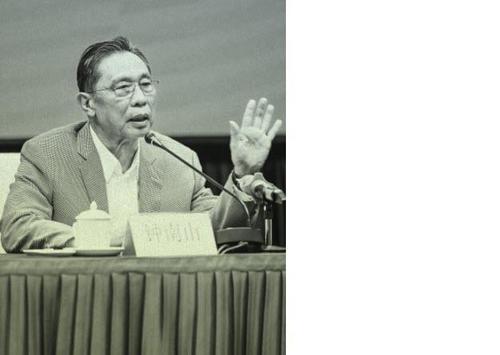
In 2012, the prominent pulmonologist Zhong Nanshan consulted on a case of miners who fell ill after digging bat feces out of a cave in Mojiang county. Their symptoms of cough, fever, and labored breathing recalled the 2002 SARS outbreak but also foreshadowed the COVID-19 pandemic.From TPG/Getty Images.
On January 14, 2021, Daszak and 12 other international experts arrived in Wuhan to join 17 Chinese experts and an entourage of government minders. They spent two weeks of the monthlong mission quarantined in their hotel rooms. The remaining two-week inquiry was more propaganda than probe, complete with a visit to an exhibit extolling President Xi’s leadership. The team saw almost no raw data, only the Chinese government analysis of it.
They paid one visit to the Wuhan Institute of Virology, where they met with Shi Zhengli, as recounted in an annex to the mission report. One obvious demand would have been access to the WIV’s database of some 22,000 virus samples and sequences, which had been taken offline. At an event convened by a London organization on March 10, Daszak was asked whether the group had made such a request. He said there was no need: Shi Zhengli had stated that the WIV took down the database due to hacking attempts during the pandemic. “Absolutely reasonable,” Daszak said. “And we did not ask to see the data…. As you know, a lot of this work has been conducted with EcoHealth Alliance…. We do basically know what’s in those databases. There is no evidence of viruses closer to SARS-CoV-2 than RaTG13 in those databases, simple as that.”
In fact, the database had been taken offline on September 12, 2019, three months before the official start of the pandemic, a detail uncovered by Gilles Demaneuf and two of his DRASTIC colleagues.
After two weeks of fact finding, the Chinese and international experts concluded their mission by voting with a show of hands on which origin scenario seemed most probable. Direct transmission from bat to human: possible to likely. Transmission through an intermediate animal: likely to very likely. Transmission through frozen food: possible. Transmission through a laboratory incident: extremely unlikely.
On March 30, 2021, media outlets around the world reported on the release of the mission’s 120-page report. Discussion of a lab leak took up less than two pages. Calling the report “fatally flawed,” Jamie Metzl tweeted: “They set out to prove one hypothesis, not fairly examine all of them.”
The report also recounted how Shi rebutted conspiracy theories and told the visiting team of experts that “there had been no reports of unusual diseases, none diagnosed, and all staff tested negative for SARS-CoV-2 antibodies.” Her statement directly contradicted the findings summarized in the January 15 State Department fact sheet. “That was a willful lie by people who know it’s not true,” said a former national security official.
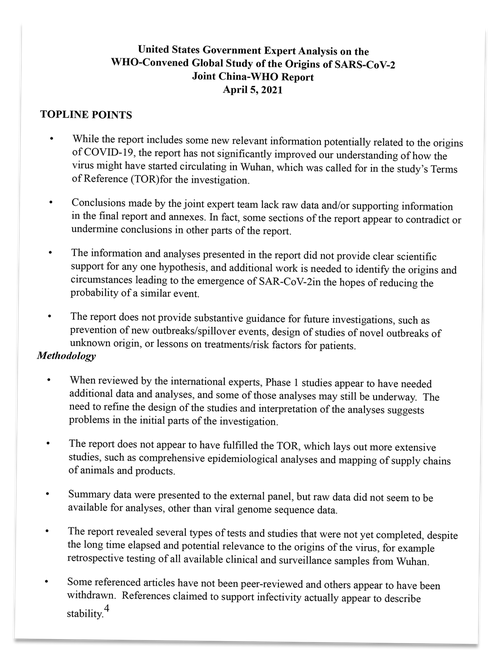
Click to see the full document
An internal U.S. government analysis of the mission’s report, obtained by Vanity Fair, found it to be inaccurate and even contradictory, with some sections undermining conclusions made elsewhere and others relying on reference papers that had been withdrawn. Regarding the four possible origins, the analysis stated, the report “does not include a description of how these hypotheses were generated, would be tested, or how a decision would be made between them to decide that one is more likely than another.” It added that a possible laboratory incident received only a “cursory” look, and the “evidence presented seems insufficient to deem the hypothesis ‘extremely unlikely.’”
The report’s most surprising critic was the WHO’s director himself, Dr. Tedros Adhanom Ghebreyesus of Ethiopia. With the credibility of the World Health Organization on the line, he appeared to acknowledge the report’s shortcomings at a press event the day of its release. “As far as WHO is concerned all hypotheses remain on the table,” he said. “We have not yet found the source of the virus, and we must continue to follow the science and leave no stone unturned as we do.”
His statement reflected “monumental courage,” said Metzl. “Tedros risked his entire career to defend the integrity of the WHO.” (The WHO declined to make Tedros available for an interview.)
By then, an international coalition of roughly two dozen scientists, among them DRASTIC researcher Gilles Demaneuf and EcoHealth critic Richard Ebright at Rutgers, had found a way around what Metzl described as a “wall of rejections” by scientific journals. With Metzl’s guidance, they began publishing open letters in early March. Their second letter, issued on April 7, condemned the mission report and called for a full investigation into the origin of COVID-19. It was picked up widely by national newspapers.
A growing number of people were demanding to know what exactly had gone on inside the Wuhan Institute of Virology. Were the claims in the State Department’s fact sheet—of sick researchers and secret military research—accurate?
Metzl had managed to question Shi directly a week before the release of the mission report. At a March 23 online lecture by Shi, hosted by Rutgers Medical School, Metzl asked if she had full knowledge of all the research being done at the WIV and all the viruses held there, and if the U.S. government was correct that classified military research had taken place. She responded:
We—our work, our research is open, and we have a lot of international collaboration. And from my knowledge, all our research work is open, is transparency. So, at the beginning of COVID-19, we heard the rumors that it’s claimed in our laboratory we have some project, blah blah, with army, blah blah, these kinds of rumors. But this is not correct because I am the lab’s director and responsible for research activity. I don’t know any kind of research work performed in this lab. This is incorrect information.
A major argument against the lab-leak theory hinged on the presumption that Shi was telling the truth when she said the WIV was not hiding any virus samples that are closer cousins to SARS-CoV-2. In Metzl’s view, if she was lying about the military’s involvement, or anything else, then all bets were off.
XI. Inside the Wuhan Institute of Virology
In January 2019, the Wuhan Institute of Virology issued a press release hailing Shi Zhengli’s “distinguished and pioneering achievement in discovery and characterization of important bat-borne viruses.” The occasion was her election as a fellow of the prestigious American Academy of Microbiology—just the latest milestone in a glittering scientific career. In China, the celebrated “Bat Woman” was easily recognizable from photos showing her in a full-body positive-pressure suit inside the WIV’s BSL-4 lab.
Shi was a fixture at international virology conferences, thanks to her “state-of-the-art” work, said James LeDuc, the longtime director of the BSL-4 Galveston National Laboratory in Texas. At the international meetings he organized, Shi was a regular, along with Ralph Baric from UNC. “She’s a charming person, completely fluent in English and French,” said LeDuc. Sounding almost wistful, he added, “This is how science works. You get everyone together, they share their data, go out and have a beer.”
Shi’s journey to the top of the virology field had begun with treks to remote bat caves in southernmost China. In 2006, she trained at the BSL-4 Jean Merieux-Inserm Laboratory in Lyon, France. She was named director of the WIV’s Center for Emerging Infectious Diseases in 2011, and its BSL-3 lab director in 2013.
It’s hard to think of anyone, anywhere, who was better prepared to meet the challenge of COVID-19. On December 30, 2019, at around 7 p.m., Shi received a call from her boss, the director of the Wuhan Institute of Virology, according to an account she gave to Scientific American. He wanted her to investigate several cases of patients hospitalized with a mysterious pneumonia: “Drop whatever you are doing and deal with it now.”
The next day, by analyzing seven patient samples, her team became one of the first to sequence and identify the ailment as a novel SARS-related coronavirus. By January 21, she had been appointed to lead the Hubei Province COVID-19 Emergency Scientific Research Expert Group. At a terrifying moment, in a country that exalted its scientists, she had reached a pinnacle.
But her ascent came at a cost. There is reason to believe she was hardly free to speak her mind or follow a scientific path that didn’t conform to China’s party line. Though Shi had planned to share isolated samples of the virus with her friend James LeDuc in Galveston, Beijing officials blocked her. And by mid-January, a team of military scientists led by China’s top virologist and biochemical expert, Major General Chen Wei, had set up operations inside the WIV.
Under scrutiny from governments including her own, with bizarre conspiracy theories and legitimate doubts swirling around her, she began lashing out at critics. “The 2019 novel coronavirus is a punishment from nature for humanity’s uncivilized habits,” she wrote in a February 2 post on WeChat, a popular social media app in China. “I, Shi Zhengli, guarantee on my life that it has nothing to do with our lab. May I offer some advice to those people who believe and spread bad media rumors: shut your dirty mouths.”
Though Shi has portrayed the WIV as a transparent hub of international research beset by false allegations, the State Department’s January fact sheet painted a different picture: of a facility conducting classified military research, and hiding it, which Shi adamantly denies. But a former national security official who reviewed U.S. classified materials told Vanity Fair that inside the WIV, military and civilian researchers are “doing animal research in the same fricking space.”
While that, in and of itself, does not prove a lab leak, Shi’s alleged lies about it are “absolutely material,” said a former State Department official. “It speaks to the honesty and credibility of the WIV that they kept this secret…. You have a web of lies, coercion, and disinformation that is killing people.”
Vanity Fair sent Shi Zhengli and the director of the Wuhan Institute of Virology detailed questions. Neither responded to multiple requests for comment by email and phone.
As officials at the NSC tracked collaborations between the WIV and military scientists—which stretch back 20 years, with 51 coauthored papers—they also took note of a book flagged by a college student in Hong Kong. Written by a team of 18 authors and editors, 11 of whom worked at China’s Air Force Medical University, the book, Unnatural Origin of SARS and New Species of Man-Made Viruses as Genetic Bioweapons, explores issues surrounding the development of bioweapons capabilities.
Claiming that terrorists using gene editing had created SARS-CoV-1 as a bioweapon, the book contained some alarming practical trade craft: “Bioweapon aerosol attacks are best conducted during dawn, dusk, night or cloudy weather because ultraviolet rays can damage the pathogens.” And it cited collateral benefits, noting that a sudden surge of hospitalizations could cause a healthcare system to collapse. One of the book’s editors has collaborated on 12 scientific papers with researchers at the WIV.

University of North Carolina virologist Ralph Baric collaborated with Shi Zhengli on a gain-of-function coronavirus experiment in 2015. In February 2020, he privately expressed support for Peter Daszak’s Lancet statement dismissing the lab-leak theory. More recently, he signed a letter calling for a transparent investigation of all hypotheses.By Christopher Janaro/Bloomberg/Getty Images.
The book’s dramatic rhetoric could have been hype by Chinese military researchers trying to sell books, or a pitch to the People’s Liberation Army for funding to launch a biowarfare program. When a reporter with the Rupert Murdoch–owned newspaper The Australian published details from the book under the headline “Chinese Held Talks on Bioweapons Benefits,” the Global Times, a Chinese state-owned media outlet, ridiculed the article, noting that the book was for sale on Amazon.
The inflammatory idea of SARS-CoV-2-as-bioweapon has gained traction as an alt-right conspiracy theory, but civilian research under Shi’s supervision that has yet to be made public raises more realistic concerns. Shi’s own comments to a science journal, and grant information available on a Chinese government database, suggest that in the past three years her team has tested two novel but undisclosed bat coronaviruses on humanized mice, to gauge their infectiousness.
In April 2021, in an editorial in the journal Infectious Diseases & Immunity, Shi resorted to a familiar tactic to contain the cloud of suspicion enveloping her: She invoked scientific consensus, just as the Lancet statement had. “The scientific community strongly dismisses these unproven and misleading speculations and generally accepts that SARS-CoV-2 has a natural origin and was selected either in an animal host before zoonotic transfer, or in humans following zoonotic transfer,” she wrote.
But Shi’s editorial had no muzzling effect. On May 14, in a statement published in Science Magazine, 18 prominent scientists called for a “transparent, objective” investigation into COVID-19’s origins, noting, “We must take hypotheses about both natural and laboratory spillovers seriously until we have sufficient data.”
Among the signers was Ralph Baric. Fifteen months earlier, he had worked behind the scenes to help Peter Daszak stage-manage the Lancet statement. The scientific consensus had been smashed to smithereens.
XII. Out of the Shadows
By spring of 2021, the debate over COVID-19’s origins had become so noxious that death threats were flying in both directions.
In a CNN interview on March 26, Dr. Redfield, the former CDC director under Trump, made a candid admission: “I am of the point of view that I still think the most likely etiology of this pathogen in Wuhan was from a laboratory, you know, escaped.” Redfield added that he believed the release was an accident, not an intentional act. In his view, nothing that happened since his first calls with Dr. Gao changed a simple fact: The WIV needed to be ruled out as a source, and it hadn’t been.
After the interview aired, death threats flooded his inbox. The vitriol came not just from strangers who thought he was being racially insensitive but also from prominent scientists, some of whom used to be his friends. One said he should just “wither and die.”
Peter Daszak was getting death threats too, some from QAnon conspirators.
Inside the U.S. government, meanwhile, the lab-leak hypothesis had survived the transition from Trump to Biden. On April 15, Director of National Intelligence Avril Haines told the House Intelligence Committee that two “plausible theories” were being weighed: a lab accident or natural emergence.
Even so, lab-leak talk was mostly confined to right-wing news outlets through April, gleefully flogged by Tucker Carlson and studiously avoided by most of the mainstream media. In Congress, the Energy and Commerce Committee’s Republican minority had launched its own inquiry, but there was little buy-in from Democrats and the NIH didn’t provide responses to its lengthy list of demands for information.
The ground began to shift on May 2, when Nicholas Wade, a former New York Times science writer known in part for writing a controversial book about how genes shape the social behavior of different races, published a lengthy essay on Medium. In it, he analyzed the scientific clues both for and against a lab leak, and excoriated the media for its failure to report on the dueling hypotheses. Wade devoted a full section to the “furin cleavage site,” a distinctive segment of SARS-CoV-2’s genetic code that makes the virus more infectious by allowing it to efficiently enter human cells.
Within the scientific community, one thing leapt off the page. Wade quoted one of the world’s most famous microbiologists, Dr. David Baltimore, saying that he believed the furin cleavage site “was the smoking gun for the origin of the virus.” Baltimore, a Nobel Laureate and pioneer in molecular biology, was about as far from Steve Bannon and the conspiracy theorists as it was possible to get. His judgment, that the furin cleavage site raised the prospect of gene manipulation, had to be taken seriously.
With questions growing, NIH director Dr. Francis Collins released a statement on May 19 asserting that “neither NIH nor NIAID have ever approved any grant that would have supported ‘gain-of-function’ research on coronaviruses that would have increased their transmissibility or lethality for humans.”
On May 24, the WHO’s decision-making body, the World Health Assembly, kicked off a virtual edition of its annual conference. In the weeks leading up to it, a parade of high-profile stories broke, including two front-page reports in The Wall Street Journal and a long Medium post from a second former New York Times science reporter. Not surprisingly, China’s government fired back during the conference, saying that it would not participate in further inquiries within its borders.
On May 28, two days after President Biden announced his 90-day intelligence review, the U.S. Senate passed a unanimous resolution, which Jamie Metzl had helped shape, calling on the World Health Organization to launch a comprehensive investigation into the origins of the virus.
Will we ever know the truth? Dr. David Relman of Stanford University School of Medicine has been advocating for an investigation like the 9/11 Commission to examine COVID-19’s origins. But 9/11 took place in one day, he said, whereas “this has so many different manifestations, consequences, responses across nations. All of that makes it a hundred-dimensional problem.”
The bigger problem is that so much time has gone by. “With every passing day and week, the kinds of information that might prove helpful will have a tendency to dissipate and disappear,” he said. “The world ages and things get moved, and biological signals degrade.”
China obviously bears responsibility for stonewalling investigators. Whether it did so out of sheer authoritarian habit or because it had a lab leak to hide is, and may always be, unknown.
The United States deserves a healthy share of blame as well. Thanks to their unprecedented track record of mendacity and race-baiting, Trump and his allies had less than zero credibility. And the practice of funding risky research via cutouts like EcoHealth Alliance enmeshed leading virologists in conflicts of interest at the exact moment their expertise was most desperately needed.
Now, at least, there appears to be the prospect of a level inquiry—the kind Gilles Demaneuf and Jamie Metzl had wanted from the start. “We needed to create a space where all of the hypotheses could be considered,” Metzl said.
If the lab-leak explanation proves accurate, history may credit Demaneuf and his fellow doubters for breaking the dam—not that they have any intention of stopping. They are now knee-deep in examining the WIV’s construction orders, sewage output, and cell phone traffic. The thought driving Paris Group cofounder Virginie Courtier forward is simple: “There are unanswered questions,” she says, “and a few human beings know the answers.”
Additional reporting by Lili Pike, with research assistance from Stan Friedman.

